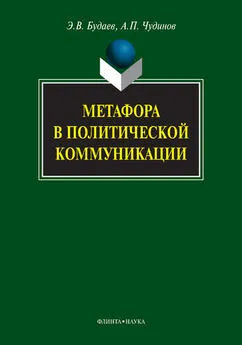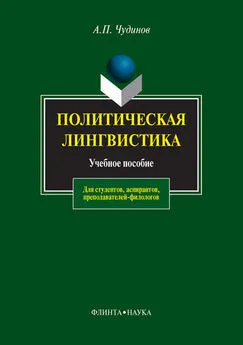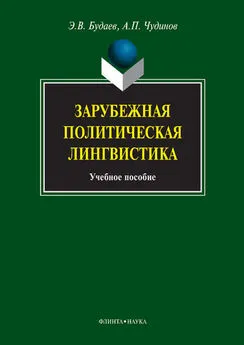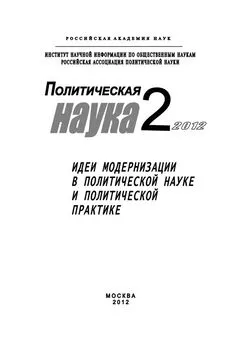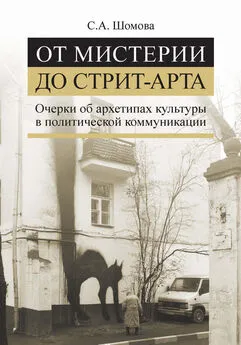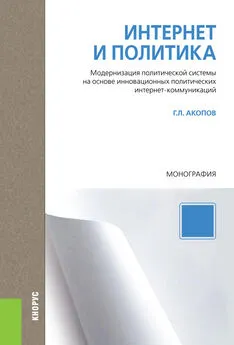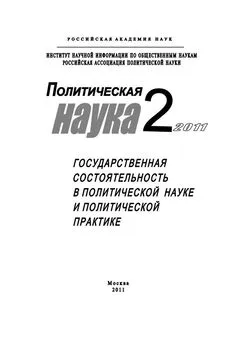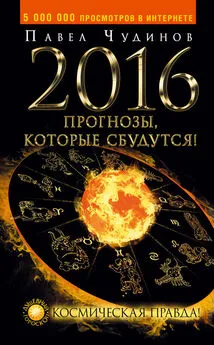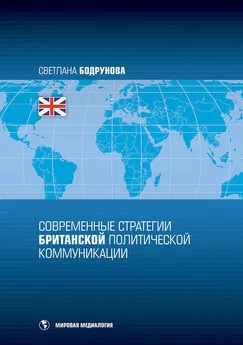Анатолий Чудинов - Метафора в политической коммуникации
- Название:Метафора в политической коммуникации
- Автор:
- Жанр:
- Издательство:Литагент «Флинта»ec6fb446-1cea-102e-b479-a360f6b39df7
- Год:2008
- Город:Москва
- ISBN:978-5-9765-0275-8, 978-5-02-034818-9
- Рейтинг:
- Избранное:Добавить в избранное
-
Отзывы:
-
Ваша оценка:
Анатолий Чудинов - Метафора в политической коммуникации краткое содержание
В монографии рассмотрена история возникновения и развития одного из динамичных направлений современной лингвистики – политической метафорологии. В последние годы в разных странах мира появились тысячи публикаций, относящихся как к традиционному (риторическому) варианту теории политической метафоры, так и ее новым направлениям – когнитивному и дискурсивному. Политическая метафорология активно развивается, современные лингвисты стремятся использовать для исследования материалы все новых и новых сфер политической коммуникации в самых разных странах и социумах. Поэтому все больше ощущается необходимость осмысления истории, современного состояния и перспектив политической метафорологии.
Для специалистов в области политической лингвистики, связей с общественностью, политологии, межкультурной коммуникации, социологии, рекламной деятельности, журналистики, государственного и муниципального управления, а также всех, кто интересуется языком политики, методами и приемами речевого воздействия в политической сфере.
Метафора в политической коммуникации - читать онлайн бесплатно ознакомительный отрывок
Интервал:
Закладка:
198. Шмелев Д.Н. Очерки по семасиологии русского языка. – М., 1964.
199. Шмелев Д.Н. Проблемы семантического анализа лексики. – М., 1973.
200. Шмелева Т.В. Морбуальная оптика // Лингвистика. Бюллетень Уральского лингвистического общества. – Екатеринбург, 2001. Т. 7.
201. Шудегова Е.А. Милитарная метафора в российском и американском политическом дискурсе // Лингвистика. Бюллетень Уральского лингвистического общества. – Екатеринбург, 2002. Т. 8.
202. Abadi A., Sacerdoti Y. Source domains of metaphors in political discourse. A cross-cultural study: Israel and the U.S.A. // RASK. 2001. Oct., 15.
203. Abrantes A.M. As Dimensoes Semantica e Pragmatica do Eufemismo na Imprensa. Uma abordagem cognitiva. – Lisboa, 2001.
204. Adamson T., Johnson G., Rohrer T., Lam H. Metaphors we ought not live by: Rush Limbaugh in the Age of Cognitive Science // philosophy.uoregon.edu/metaphor/rush.htm. 1998.
205. Aden R. Entrapment and Escape: Inventional Metaphors in Ronald Reagan's Economic Rhetoric // Southern Communication Journal. 1988. Vol. 54.
206. Ahrens K. When Love is Not Digested: Underlying Reasons for Source to Target Domain Pairings in the Contemporary Theory of Metaphor // Proceedings of the First Cognitive Linguistics Conference / ed. Yuchau E. Hsiao. – Taipei, 2002.
207. Ahrens K., Chung S., Huang C. From Lexical Semantics to Conceptual Metaphors: Mapping Principle Verification with WordNet and SUMO // Proceedings of the 5 thChi nese Lexical Semantics Workshop (CLSW-5). – Singapore, 2004.
208. Akioye A.A. The Rhetorical Construction of Radical Africanism at the United Nations: Metaphoric Cluster as Strategy // Discourse and Society. 1994. Vol. 5. № 1.
209. Allhoff D. – W. Rhetorische Analyse der Reden und Debatten des ersten deutschen Parlamentes von 1848/49. Insbesondere auf syntaktischer und semantischer Ebene. – Munchen, 1975.
210. Anderson R.D., jr. The Causal Power of Metaphor in Politics // www.sscnet.ucla.edu/polisci/faculty/anderson/MetaphorsCauses.htm. 2002a.
211. Anderson R.D., jr. The Discursive Origins of Russian Democratic Politics // http://www.sscnet.ucla.edu/polisci/faculty/Anderson/AFHRChapter.htm. 2001.
212. Anderson R.D., jr. Metaphors of Dictatorship and Democracy: Change in the Russian Political Lexicon and the Transformation of Russian Politics // http://www.sscnet.ucla.edu/polisci/faculty/anderson/Metaphor13.htm. 2002b.
213. Andersson T. Metaphorical Reasoning and Real Prototypes. Empirical Studies of Metaphors and Prototypes of Forest // www.lucs.lu.se/ftp/pub/LUCS_Studies/LUCS20.ps. 1993.
214. Arendt D. Geschichten und Lieder vom Rattenfanger oder Sprache und Bild als demagogische Handlung // Frankfurter Hefte. 1983. Bd. 38. H. 12.
215. Augoustinos M., Penny S.L. Reconciliation: The Genesis of a New Social Representation // Papers on Social Representations. 2001. Vol. 10.
216. Ausmus W. Pragmatic Uses of Metaphor: Models and Metaphor in the Nuclear Winter Scenario // Communication Monographs. 1998. Vol. 65. № 1.
217. Avise J.C. Evolving Genomic Metaphors: A New Look at the Language of DNA // Science. 2001. Vol. 294. № 5540.
218. Baars B.J. Metaphors of consciousness and attention in the brain // Trends in Neurosciences. 1998. Vol. 21. № 2.
219. Bachem R Einfuhrung in die Analyse politischer Texte. – Munchen, 1979.
220. Bachem R., Battke K. Strukturen und Funktionen der Metapher Unser Gemeinsames Haus Europa im aktuellen politischen Diskurs // Begriffe besetzen. Strategien des Sprachgebrauchs in der Politik Opladen / ed. F. Liedtke, M. Wengler, K. Boke. – Opladen, 1991.
221. Bachem R., Battke K.Unser gemeinsames Haus Europa: Zum Handlungspotential einer Metapher im offentlichen Meinungsstreit // Muttersprache. 1989. Bd. 99.
222. Baker P., McEnery T. A corpus-based approach to discourses of refugees and asylum seekers in UN and newspaper texts // Journal of Language and Politics. 2005. Vol. 4. № 2.
223. Baranov A.N., Dobrovol'skij D.O. Metaphern im deutschen und russischen offentlichen Diskurs // www.daad.ru/wort/wort2003/ Baranov.Druck.pdf. 2003.
224. Baranov A., Zinken J. Die metaphorische Struktur des offentlichen Diskurses in Russland und Deutschland: Perestrojka-und Wende-Periode // Metapher, Bild und Figur: Osteuropaische Sprach-und Symbolwelten / B. Symanzik et al. (eds). – Hamburg, 2003.
225. Barnden J.A., Glasbey S.R., Lee M.G., Wallington A.M. Varieties and directions of inter-domain influence in metaphor // Metaphor and Symbol. 2004. Vol. 19. № 1.
226. Bartels L.M. Presidential primaries and dynamics of public choice. – Princeton, 1988.
227. Bartsch Ch. Metaphernkonzepte in Pressetexten. Das Verhaltnis der Schweiz zu Europa und zur Europaischen Union. – Zurich, 2004.
228. Bass A.M. The metaphor of the human body in the political theory of John of Salisbury: context and innovation // Metaphor and Rational Discourse / ed. Debatin, Bernhard/ Jackson, Timothy R./Steuer, Daniel (edd.). – Tubingen, 1997.
229. Bates B.R. Audiences, Metaphors, and the Persian Gulf War // Communication Studies. 2004. Vol. 55. № 3.
230. Baysha O., Hallahan K. Media framing of the Ukrainian political crisis, 2000–2001 // Journalism Studies. 2004. Vol. 5. № 2.
231. Bebermeyer R. «Krise» in der Krise: Eine Vokabel im Sog ihrer Komposita und auf dem Weg zum leeren Schlagwort // Muttersprache. 1981. Bd. 91.
232. Beer F.A., Balleck B.J. Body, Mind, and Soul in the Gulf War Debate / / The Theory and Practice of Political Communication Research / Mary E. Stuckey (ed.). – Albany, 1996.
233. Beer F.A., De Landtsheer C. Metaphors, Politics and World Politics // Metaphorical World Politics / Eds. F.A. Beer, C. De Landtsheer. – East Lancing, 2004.
234. Belt T.L. Metaphor and political persuasion. – Los Angeles, 2003.
235. Benoit W.L. Framing through temporal metaphor: The «bridges» of Bob Dole and Bill Clinton in their 1996 acceptance addresses // Communication Studies. 2001. Vol. 52.
236. Benoit W.L. The functional theory of political campaign discourse // Известия УрГПУ. Лингвистика. – Вып. 18. – Екатеринбург, 2006.
237. Benoit W.L., Klyukovski A.A., Mchale J.P., Airne D. A fantasy theme analysis of political cartoons on the Clinton-Lewinsky-Starr affair // Critical Studies in Media Communication. 2001. Vol. 18 (4).
238. Bergen B. To Awaken a Sleeping Giant: Cognition and Culture in 23 September 11 Political Cartoons // Language, Culture, and Mind / ed. M. Achard, S. Kemmer. – Stanford, 2004.
239. Bergsdorf W. Kampf um Begriffe – Aufgaben der politischen Semantik// Universitas. 1985. Bd. 40.
240. Bergsdorf W. Politik und Sprache. – Munchen; Wien, 1978.
241. Berho D.L. Working Politics: Juan Domingo Peron's Creation of Positive Social Identity // Rocky Mountain Review of Language and Literature. 2000. Vol. 54. N 2.
242. Berschin H. Liebe Freundinnen und Freunde. U ber die Sprache der Grunen im Bundestag // Die Grunen – Partei wider Willen / Klaus Gotto / Hans-Joachim Veen (Hg.). – Mainz, 1984.
243. Betz W. Sprachlenkung und Metaphernstrategie und andere Tendenzen deutscher Sprachentwicklung // Sprache im technischen Zeitalter. 1977. Bd. 63.
244. Bilgin E. An analysis of Turkish modernity through discourses of masculinities: A thesis for the degree of doctor of philosophy in political science. – Ankara, 2004.
245. Bineham J.L. Some ethical implications of team sports metaphors in politics // Communication Reports. 1991. Vol. 4.
246. Bishop G., Meadow R.G., Jackson-Beeck M. (Eds.). The Presidential Debates. – New York, 1980.
247. Bitzer L. Rueter T. Carter vs Ford: The counterfeit debates of 1976. -Madison, 1980.
248. Boke K. Die «Invasion «aus den «Armenhausern Europas». Metaphern im sdiskurs // Die Sprache des Migrationsdiskurses. Das Reden uber «Auslander» in Medien, Politik und Alltag. – Opladen, 1997.
249. Blankenship J. The search for the 1972 Democratic nomination: A metaphorical perspective // Rhetoric and communication: Studies in the Illinois tradition / J. Blankenship & H.G. Stelzner (Eds.). – Urbana, 1973.
250. Borkowski I. A metafory trwaja… Przenosnia jako srodek perswazji jezykowej w czasie kampanii wyborczej w 1991 i 1995 r. // Rozprawy Komisji Jezykowej XXII. – Wroclaw, 1996.
251. Bosman J. Persuasive effects of political metaphors // Metaphor and Symbolic Activity. 1987. Vol. 2. N 2.
252. Bosman J., Hagendoorn L. Effects of literal and metaphorical persuasive messages // Metaphor and Symbolic Activity. 1991. Vol. 6(4).
253. Braden W., Brandenbärg E. Roosevelt's Fireside Chats // Communication Monographs. 1955. Vol. 22.
254. Brandenbärg E., Braden W. Franklin D. Roosevelt's Voice and Pronunciation // Quarterly Journal of Speech. 1952. Vol. 38.
255. Braziene V. Conceptual metaphors in different types of discourse // Respectus Philologicus. 2004. № 5(10).
256. Brembeck C. Harry Truman at the Whistle Stops // Quarterly Journal of Speech. 1952. Vol. 38.
257. Brown G., Yule G. Discourse Analysis. – Cambrige, 1983.
258. Brown T.Making Truth. The Roles of Metaphor in Science. – Champaign, 2003.
259. Brugman C. What is the Invariance Hypothesis? // Cognitive Linguistics. 1990. Vol. 1 № 2.
260. Buell E.H., JR… Maus M. Is the pen mightier than the word? Editorial cartoons and 1988 presidential nominating politics // Political Science and Politics. 1988. Vol. 21(3).
261. Burke K. Rhetoric of motives. – Berkeley, 1969.
262. Burkhardt A. Konnen Worter lugen? // Universitas. Zeitschrift fur interdisziplinare Wissenschaft. 1992. Bd. 47.
263. Burkhardt A. Metaphors We Die By. Die todliche Metaphorik von Rustungswerbung, Innen-und Militarpolitik / N. Oellers (Hg.): Germanistik und Deutschunterricht im Zeitalter der Technologie: Selbstbestimmung und Anpassung. Vortrage des Germanistentages. – Berlin 1987. – Band 2: Politische Aufgaben und soziale Funktionen von Germanistik und Deutschunterricht. – Tubingen, 1988.
264. Caglar A.S. Constraining metaphors and the transnationalisation of spaces in Berlin // Journal of Ethnic and Migration Studies. 2001. Vol. 27. № 4.
265. Candel B. Political Islam and Translation Metaphors and Frames in Media Reporting and Islamist Rhetoric. – Guildford, 2005.
266. Canedo L.B. As metaforas da famflia na transmissao do poder politico: questoes de metodo // Cadernos Cedes. 1997. Vol. 18. № 42.
267. Carpenter R.H. America's Tragic Metaphor: Our Twentieth-Century Combatants as Frontiersmen // Quarterly Journal of Speech. 1990. Vol. 76.
268. Carpenter D.P. The corporate metaphor and executive department centralization in the United States, 1888–1928 // Studies in American Political Development. 1998. Vol. 12(1).
Читать дальшеИнтервал:
Закладка:
